 A recently completed cooperative study between the S.C. Department of Natural Resources (DNR), Auburn University, and Brosnan Forest will help researchers and hunters better understand buck movements and behavior around food plots and deer stands. According to Charles Ruth, Deer and Turkey Program coordinator for DNR, this is one in a series of cooperative studies conducted in South Carolina made possible by revenue associated with deer hunter’s participation in antlerless deer tag programs offered by DNR.
A recently completed cooperative study between the S.C. Department of Natural Resources (DNR), Auburn University, and Brosnan Forest will help researchers and hunters better understand buck movements and behavior around food plots and deer stands. According to Charles Ruth, Deer and Turkey Program coordinator for DNR, this is one in a series of cooperative studies conducted in South Carolina made possible by revenue associated with deer hunter’s participation in antlerless deer tag programs offered by DNR.
Clint McCoy conducted the study while working on his Ph.D. at Auburn University under the direction of Dr. Steve Ditchkoff, Ireland Professor of Wildlife Ecology. The study was conducted on the Brosnan Forest Conference Center which is owned by Norfolk Southern Railway and located in Dorchester County. According to Josh Raglin, General Manager of Brosnan Forest, “The property is actively managed for timber and wildlife and has been involved in deer research with Auburn University and DNR for a number of years.”
McCoy’s study involved capturing bucks and fastening GPS collars around their necks. During the 3 year study about 40 bucks were captured with approximately 10 bucks in each age class from 1.5 to 4.5 years old. The GPS units were programmed to record a location every 30 minutes and over the course of the study more than 115,000 locations were recorded.
Hunters often wonder about the size of a buck’s home range and how far they move. McCoy found that although home ranges varied among bucks the average range was only 350 acres which is relatively small and most likely due to the high quality habitat at Brosnan Forest. Although some hunters believe that older bucks move more than younger bucks, there were no statistical differences in home range size based on age. “Also, as you would expect” said McCoy, “buck movements increased from an average of about 2.5 miles a day during the pre-rut to about 3.5 miles per day during the rut. So even with relatively small home ranges bucks still moved considerable distances on a daily basis related to breeding.”
The study also looked at the impact of hunting pressure on buck movements and tested the notion often held by hunters that older bucks are “smarter” than young bucks. McCoy said, “To do this we created ‘harvest zones’ around each deer stand on the property with a buffer representing the area around each stand in which a hunter could see and harvest a deer. Using daytime GPS locations (since hunting does not take place at night), we found that all bucks, regardless of age, responded negatively to increased hunting pressure. By late November the chances of a buck entering the harvest zone during daylight hours were only a quarter of what they were when the season started.”
“On the other hand,” said McCoy, “bucks of all ages actually increased their use of food plots as the season progressed, however, this increase in use was at night. Finally, we looked at the question of how long after a stand is hunted do bucks continue to show avoidance for the area. Based on the data it appears that buck avoidance of a stand lasts about 3 days following hunting. However, even after 5 days they were not as likely to visit the site as they were before the stand was ever hunted. The bottom line is that the more a stand is hunted the less likely bucks are to pass through the area during daytime. For hunters it is best to be unpredictable when choosing your hunting locations.” said McCoy.
Charles Ruth with DNR added, “Clint did a great job on this project and we recently began work with Dr. Ditchkoff at Auburn University and the folks at Brosnan Forest to initiate a similar study to monitor adult female deer using GPS technology to better understand their movements and behaviors during the hunting and breeding season.”
Read more about Clint McCoy’s study by visiting the following websites which were made available by the Quality Deer Management Association: http://www.qdma.com/articles/gps-reveals-early-season-buck-movement-patternsand http://www.qdma.com/articles/new-data-on-buck-home-range-size-by-age .

